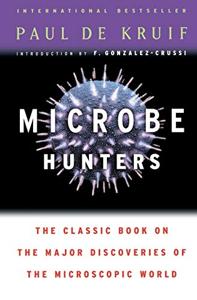
Want to learn the ideas in Microbe Hunters better than ever? Read the world’s #1 book summary of Microbe Hunters by Paul de Kruif here.
Read a brief 1-Page Summary or watch video summaries curated by our expert team. Note: this book guide is not affiliated with or endorsed by the publisher or author, and we always encourage you to purchase and read the full book.
Video Summaries of Microbe Hunters
We’ve scoured the Internet for the very best videos on Microbe Hunters, from high-quality videos summaries to interviews or commentary by Paul de Kruif.
1-Page Summary of Microbe Hunters
Overall Summary
Paul Henry de Kruif’s Microbe Hunters (1926) is a book about the earliest discoveries of microbes by scientists. It explains how vaccinations were discovered and where they come from. The book is still widely respected today as it was in 1926 when it was first published. DeKruif wrote other books that are also well-known, including one that inspired Sinclair Lewis to write Arrowsmith, which won the Pulitzer Prize for literature in 1925.
Microbe Hunters is about the first scientists who discovered microbes and bacteria. We know that these cause illnesses, but it didn’t used to be this way. De Kruif tells us stories of those early pioneers so we can remember how far science has come with vaccines.
Microbe Hunters is a book that focuses on the lives of scientists and their discoveries. The first microbe hunters were people who found microbes without knowing what they were, whereas later scientists studied these organisms to learn about them. This book was written in 1926, so it’s outdated by today’s standards, but it can still be used as a study guide for students.
Microbe Hunters is the story of Antony Leeuwenhoek, who was a scientist in Holland during the seventeenth century. He was one of the first people to discover microbes, but he has largely been forgotten by modern society. De Kruif explains that because Leeuwenhoek grew up illiterate and never attended university, he made his most important discoveries without any bias or preconceived notions about science.
Leeuwenhoek was the first to discover microbes. He didn’t have any mentors, so he taught himself how to make a microscope and observed them using his own senses. He paved the way for microbial science by discovering these strange shapes moving around inside a droplet of water.
Leeuwenhoek is important because he was a scientist who made discoveries by chance. De Kruif reminds us that many great scientific discoveries were accidental, such as the fact that microbes reproduce. Spallanzani wasn’t a typical scientist either; he learned about microbes through trial and error. He loved to learn how things worked, and he went on to prove that microbes reproduce in this way.
Microbial study fell silent for many years after Spallanzani’s discovery. Scientists accepted that microbes exist, but they didn’t realize how dangerous and deadly they can be. No one realized that microbes cause disease in people until the 1830s, when scientists discovered their link to illness.
In the 1830s, a boy called Louis Pasteur questioned why people died after being bitten by dogs. He was told that it was because of demons in mad dogs. He refused to accept this and believed that there were microbes causing illness instead.
Another scientist, however, declared that he could prove that microbes caused sickness. He stole the limelight from Pasteur. This scientist was Robert Koch, and his claims made Pasteur more determined than ever to complete his life’s work. Eventually, Pasteur proved that infecting animals with small amounts of microbes didn’t kill them; instead they recovered from the infection. He paved the way for the first vaccinations by proving dog bites transferred lethal microbes to a person’s body.
De Kruif acknowledges that the eighteenth and nineteenth centuries were terrible times for animals. Scientists experimented on all sorts of animals, including guinea pigs and chickens. They killed many of these creatures in order to find ways to defeat dangerous microbes. Animal welfare didn’t exist at this time because scientists thought they could do whatever they wanted with animals without worrying about hurting them or killing them. Readers should be aware that de Kruif describes animal experiments in some detail in his book, which was written during this period when animal welfare did not exist as a consideration for scientists who performed these types of studies.






